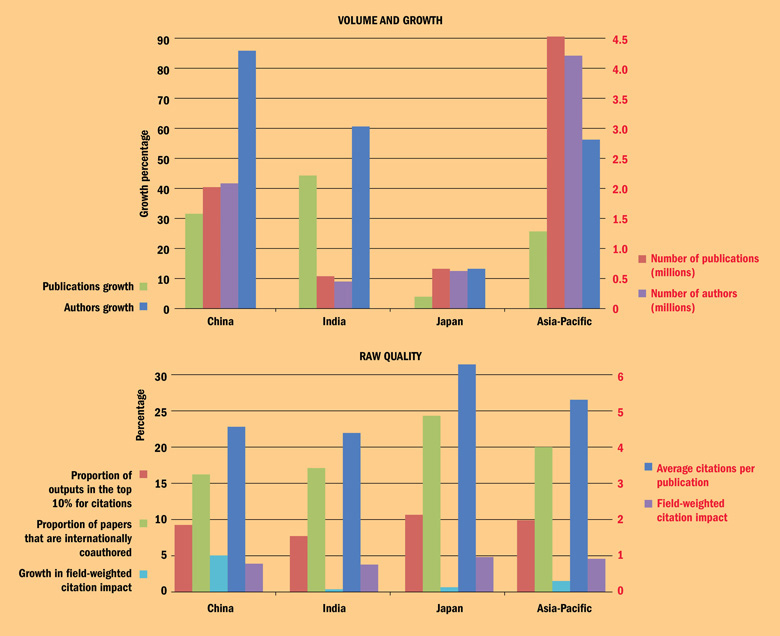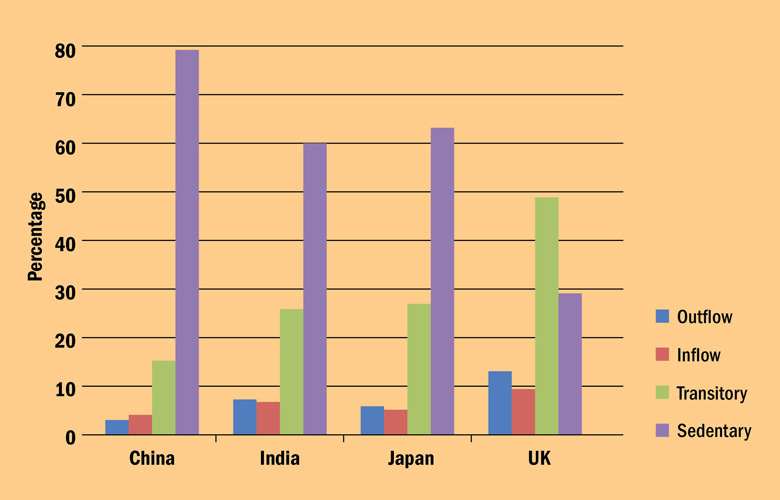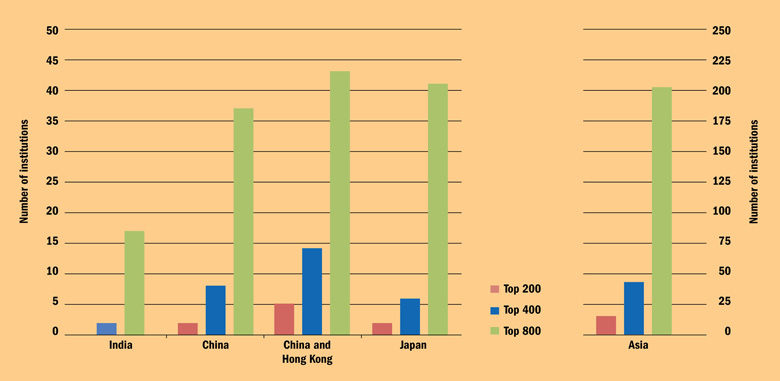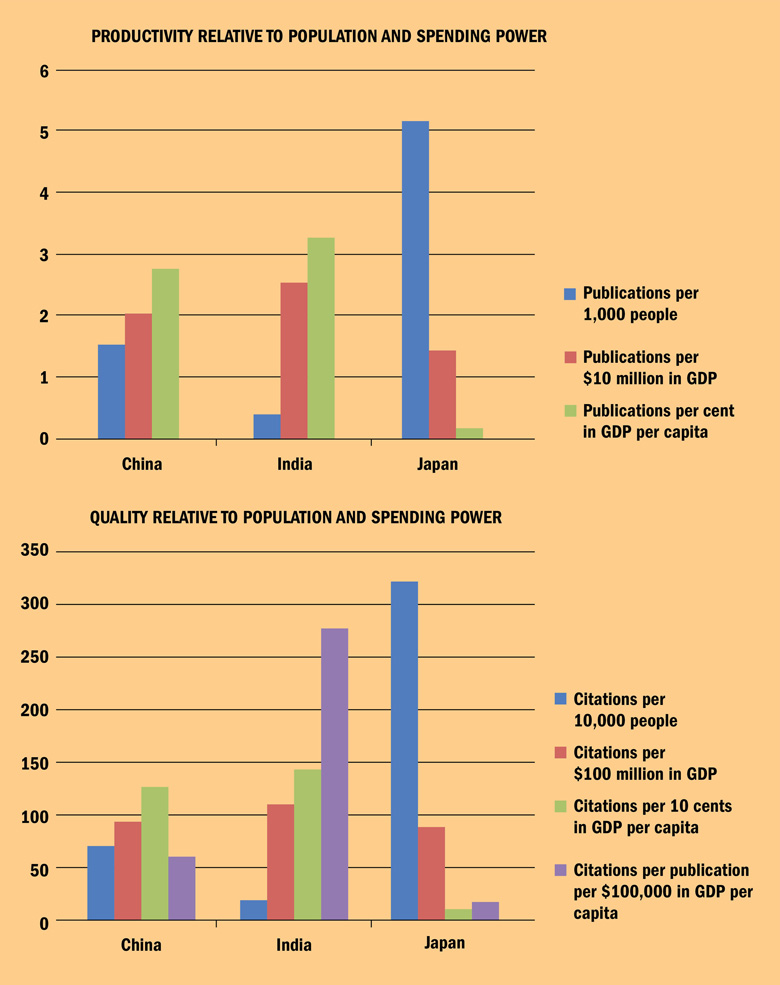In the so-called Asian century, no one could dispute that China and India will be the future giants of world higher education.
When India overtook China as the world’s fastest growing major economy earlier this year, it made headlines around the globe. The country is projected to ride its population explosion to become the third-largest economy in the world by 2030 on some estimates. But, despite its recent economic wobbles, China is still expected to surpass the US as the largest economy by the same date.
Highly educated people will, of course, be crucial to that growth, and the demand for university places is projected to mushroom in both nations. According to Unesco 2013 figures, China has 34 million students enrolled in higher education, while India has 28.2 million (the US has only 20 million). Together, the two Asian giants host a third of the world’s higher education students.
As demographic changes bring stagnation in young populations in many Western countries, China and India will become ever more important markets for student recruitment. And while their systems and leading institutions do not yet rival the West in terms of research quality or reputation, their sheer size will mean that universities around the world will inevitably find themselves collaborating and competing with them to an ever greater extent.
But while they have a continent and a raft of vertiginous socioeconomic projections in common, India and China are very different in many respects. One of the many economists to have compared development in the two nations is Nobel prizewinner Amartya Sen, Thomas W. Lamont university professor and professor of economics and philosophy at Harvard University. Sen’s 2013 New York Times opinion piece, titled “Why India trails China”, lamented India’s underperformance relative to China and pinpointed the gulf between education strategies as a key factor. “India’s underperformance can be traced to a failure to learn from the examples of so-called Asian economic development, in which rapid expansion of human capability is both a goal in itself and an integral element in achieving rapid growth,” he argued.
One example he cited is Japan. Beginning in the mid-19th century, “investments in education and health care” enabled the island nation to raise its “living standards and labour productivity”. Japan’s model of governmental collaboration with the market was followed in the post-war period by other East Asian nations, including South Korea and China, Sen argued.
Sen tells Times Higher Education that “one of the main differences between India and China is that the Indian school system…for the general public (as opposed to the privileged few) is in a huge mess, and this affects the standards that can be generated and maintained at the Indian universities”.
Overall research performance across Asia
Source: Elsevier’s Scopus database.
Notes: All bibliometric figures refer to the years 2010–2014. Field-weighted citation impact is a measure of the citation impact of research benchmarked against other research in the same field. Growth rates are calculated according to the compound annual growth rate.
He adds of universities: “The general improvement that we notice in China (as far as I have been able to observe) is not really replicated in India – at least, not noticeably so, except perhaps in education for engineering of various kinds, in which many of the Indian Institutes of Technology [IITs] have flourished, at least in teaching, though less so in research.”
Philip Altbach, research professor and founding director of the Center for International Higher Education at Boston College, wrote in a 2009 journal paper, “One-Third of the Globe: the Future of Higher Education in China and India”, that China “has moved consciously toward a differentiated academic system, having so far paid special attention to the top of the system, especially to the 150 or so research universities that are the responsibility of the central government”.
But while India has “a widely respected, small, elite sector of specialised academic institutions”, most notably the IITs, there is “no clear differentiation among the universities”, and the nation’s higher education sector “has grown without planning in response to massification and the need for new kinds of institutions to serve an expanding economy”, Altbach argued.
At one level, this is borne out by the THE World University Rankings. In the latest rankings, China has two institutions – Peking and Tsinghua universities – inside the top 200, ranked 42nd and 47th respectively, and Hong Kong has another three, headed by the University of Hong Kong, at joint 44th. India has none: its highest-ranked university, the Indian Institute of Science, is listed in the 251-300 bracket.
In the THE Asia Rankings, which lists Asia’s top 100 institutions using a slightly different methodology, China has 21 institutions, with Peking and Tsinghua placed fourth and fifth, and Hong Kong has another six, with the University of Hong Kong placed third. India has nine representatives, with the Indian Institute of Science placed 37th.
Meanwhile, data compiled for THE by Elsevier from its Scopus citation database reveal that China produces about four times as many papers as India (see graph, above). But India is closing the gap: its compound annual growth rate in publication volume between 2010 and 2014 outstrips that of China and it looks set soon to produce more papers than Japan, Asia’s traditional research powerhouse.
And while Japan still leads the way on research quality, China’s annual growth rate in field-weighted citation impact (which compares papers’ citation impact with that of others within the same field) is much greater. India’s current research quality is not far behind China’s on several measures, including field-weighted citation impact. But its growth rate on the latter measure is much lower.
A comparison of researcher mobility
Source: Elsevier’s Scopus database.
Notes: Regarding mobility, “outflow” indicates researchers whose affiliation has changed from Country X to another country. “Inflow” indicates researchers whose affiliation has changed from another country to Country X. “Transitory” indicates researchers whose affiliation country has changed from Country X to another country and/or vice versa multiple times. “Sedentary” indicates researchers whose affiliation country did not change between 1996 and 2014. Percentages are based on “active” researchers only, defined as either those who produced at least four papers in the last five years or those that produced 10 or more papers between 1996 and 2014 and at least one in the last five years.
One reason for India’s low productivity and quality relative to China is no doubt its comparative poverty. But, in the eyes of some, the different political structures of the two countries are also a major factor in higher education performance. Unlike China’s centralised power structure, democratic India has a federal system of government. Accordingly, it has three principal kinds of higher education institutions: central government universities, state universities and private universities.
Francisco Marmolejo, the World Bank’s lead tertiary education specialist, says that Chinese central planning “in a way allows the state to dictate significant developments affecting higher education as a whole, while in India a significant level of decentralisation has been prevalent for many years despite efforts from the central government to establish some type of regulation”.
Hence, “efforts aimed at changing [Chinese] institutions can be more easily implemented, while, in the case of India, key involvement of the state governments is required, and [the] effectiveness of actions is limited [by] the excessive institutional fragmentation of the higher education system”, he adds.
In a 2015 paper, “Higher education reform in India and China: the role of the state”, Devesh Kapur of the University of Pennsylvania and Elizabeth J. Perry of Harvard University write that while the Chinese Communist Party’s “interference” in academia is often criticised as an impediment to the development of “great universities”, it should also be acknowledged that close government-university connection “affords the Chinese state a strategic advantage in targeting [resources] in service to its own national and local priorities”.
Strategies from the Chinese government notably include selective funding of the C9 League of leading research-intensive institutions – seven of which are inside the top 50 of THE’s Asia Rankings. Joshua Mok Ka-Ho, vice-president and chair professor of comparative policy at Hong Kong’s Lingnan University, says: “As a developmental state with a strong political will to do well globally, the Chinese regime will try every means to position the country and steer the resources from the whole nation to make sure some selected universities become globally leading.
“Compared to India as a full democracy, the Chinese universities will be moving [in] a direction guided by the Chinese government, rather than engaging in endless debates. It is the beauty of being centralised and directed for development, but it might affect the extent of academic freedom that universities and academics enjoy in China. However, for the sake of nation building and the quest for world-class status, the Chinese development model [seems] more efficient.”
China
Largest subject areas
| Subject area | Publications | Publications (growth %) | Authors | Growth in authors (%) | Citations per publication | Field-weighted citation impact |
| Engineering | 796,504 | 50.6 | 910,278 | 84.7 | 2.7 | 0.70 |
| Computer science | 350,796 | -23.4 | 409,597 | 1.4 | 2.3 | 0.69 |
| Medicine | 322,427 | 99.0 | 596,977 | 169.4 | 5.4 | 0.85 |
| Materials science | 310,703 | 45.1 | 401,669 | 78.9 | 7.0 | 1.03 |
| Physics and astronomy | 309,992 | 33.3 | 375,371 | 70.5 | 5.3 | 0.86 |
Top-performing subjects
| Subject area | Publications | Publications (growth %) | Authors | Growth in authors (%) | Citations per publication | Field-weighted citation impact |
| Dentistry | 3,094 | 79.7 | 7,145 | 132.6 | 6.6 | 1.31 |
| Chemistry | 241,578 | 58.4 | 336,846 | 91.7 | 10.9 | 1.27 |
| Chemical engineering | 123,831 | 74.5 | 228,343 | 106.1 | 10.1 | 1.27 |
| Psychology | 4,740 | 130.3 | 9,400 | 191.5 | 6.6 | 1.21 |
| Economics, econometrics and finance | 10,788 | 49.8 | 14,439 | 37.2 | 3.7 | 1.10 |
India
Largest subject areas
| Subject area | Publications | Publications (growth %) | Authors | Authors (growth %) | Citations per Publication | Field-weighted Citation Impact |
| Medicine | 117,812 | 80.5 | 156,999 | 95.3 | 4.4 | 0.73 |
| Engineering | 97,356 | 100.9 | 111,477 | 102.9 | 3.6 | 0.92 |
| Chemistry | 71,517 | 45.0 | 75,184 | 46.5 | 7.6 | 0.93 |
| Physics and astronomy | 69,989 | 36.6 | 59,001 | 45.1 | 5.8 | 0.92 |
| Computer science | 69,499 | 84.8 | 77,540 | 90.8 | 2.0 | 0.78 |
Top-performing subjects
| Subject area | Publications | Publications (growth %) | Authors | Authors (growth %) | Citations per Publication | Field-weighted Citation Impact |
| Chemical engineering | 32,187 | 96.3 | 49,191 | 98.6 | 8.1 | 1.05 |
| Nursing | 1,794 | 59.9 | 4,432 | 57.6 | 6.7 | 1.00 |
| Energy | 16,518 | 68.4 | 25,203 | 73.4 | 6.0 | 0.99 |
| Materials science | 61,802 | 44.3 | 60,272 | 52.9 | 6.7 | 0.98 |
| Chemistry | 71,517 | 45.0 | 75,184 | 46.5 | 7.6 | 0.93 |
Source: Elsevier’s Scopus database
Speaking to THE earlier this year, Glyn Davis, vice-chancellor of the University of Melbourne, observed that South Korea and Singapore – which have two representatives each in the top 10 of THE’s Asia Rankings – have adopted a similar policy of pouring money into top institutions: “So there’s an Asian approach to university funding that appears, on the current evidence of the rankings, to be propelling a number of [East] Asian universities into the world’s first rank,” he said.
Indeed, even India is now planning its own C9-style scheme, although it will involve private as well as public institutions. Arun Jaitley, India’s finance minister, announced in his budget speech in February that an “enabling regulatory architecture will be provided to 10 public and 10 private institutions to emerge as world-class teaching and research institutions”. The plan is mainly focused on allowing the selected universities more freedom from government control, enhancing their ability to set salaries and tuition fees, establish new courses and collaborate with foreign institutions.
Jaitley also announced that a not-for-profit Higher Education Financing Agency will be created to “leverage funds from the market” to support infrastructure improvements in “top institutions”. But details about the proposals remain scarce, and if reports that the Indian government may seek to enact the changes via legislation are accurate, there is a risk that they may be rejected by India’s parliament. The previous Indian administration tried several times to push through a bill allowing foreign universities to establish themselves in India, but members of parliament were steadfast in their opposition.
Moreover, the current administration, led by the Hindu nationalist BJP, has attracted claims that, far from enhancing institutional autonomy, it is actually attacking it. Sen argues that “the element of [government] authoritarianism that has always been present in terms of funding of universities” and selection of vice-chancellors “has vastly increased since the new government…came to office [in 2014]. Right now there is a huge set of protests in universities across India about governmental high-handedness in appointing institutional heads, in line with the Hindutva [Hindu nationalist] philosophy championed by the government, and several universities right now are in turmoil.” He notes that the buffer between government and universities that the country’s University Grants Committee is intended to provide “has weakened greatly in the recent past”.
Tensions between left-wing students and the BJP have been running high at various institutions in recent months, notably Jawaharlal Nehru University (“The battle for the Indian mind”, Feature, 5 May). Sen himself was at the centre of a clash with the BJP over his chancellorship at Nalanda University, opened in 2014 as a modern revival of an ancient institution that was destroyed by invaders in 1193 and is sometimes regarded as the world’s first university. Assent from the university’s visitor, the Indian president, was required for his reappointment, but Sen quit when that approval was delayed.
Number of institutions in the THE World University Rankings 2015-16
“I moved away…primarily because the government clearly wanted to have a big fight with the governing board...on the board’s choice of my continuing as chancellor, and it seemed to me not good for the university to be in a hostile relationship with the government of India, which provides most of the funds,” Sen explains. “In various communications it was quite clear that the government took the view that since they finance the university, they should make the final decision of what happens at the higher level of the university. This is, of course, a departure from a long-established European tradition, which India had tried to follow, with some hiccups, since independence, until the very recent years.”
Sen’s view that India’s higher education system compares unfavourably with China’s is a common one. Boston College’s Altbach tells THE, “India has so far done very poorly in all aspects of higher education except for the IIT and IIM [Indian Institutes of Management] sector, which is very small, and a few promising but as yet largely unproven non-profit private universities bankrolled by a few tycoons.”
But, in terms of research, it is worth looking a bit more closely before lamenting Indian underperformance too loudly. Per head of population, India produces many fewer papers and attracts many fewer citations than either Japan or China, with the former the clear leader on those measures (see graphs, below). But when national wealth is taken into account, India starts to look like a much stronger performer. It outscores both China and Japan in terms of both publications and citations relative to its GDP. And in terms of citations per publication (a measure of quality) relative to GDP per capita (a measure of individuals’ spending power), India dwarfs China and Japan.
India also outperforms China in the proportion of its papers that are internationally co-authored (although Japan outscores them both). In addition, India’s researchers are more internationally mobile than either China’s or Japan’s (see 'A comparison of researcher mobility' graph, above).
Citing Unesco statistics on China alongside Indian government figures, Kapur and Perry write that total government spending on education amounts to 4.2 per cent of GDP in India and 4.3 per cent in China, with broadly similar proportions of that spending going to higher education (18 per cent in India and 20 per cent in China). But GDP remains far lower in India than in China.
In his 2015 book An Economist in the Real World, Kaushik Basu, senior vice-president and chief economist at the World Bank, recalls his experience of serving on an Indian government advisory committee on higher education in 2008. He writes that India has two advantages in higher education: “its widespread use of the English language and its longstanding tradition of higher education and research”. Boosts to institutional differentiation, private sector involvement and foreign collaboration could see India “become a global hub for education”, says Basu, who went on to become chief economic adviser to the previous Congress-led Indian government. The country could even attract “students from rich countries” by offering quality education at far cheaper prices than in the West – the profits from which “can be used to expand India’s own domestic education and raise its gross enrolment ratio”, Basu says.
Productivity and quality v size and wealth
Source: Elsevier’s Scopus database.
Notes: Figures for GDP and population are World Bank figures for 2014.
But Lingnam’s Mok argues that China should not be seen as lagging behind on internationalisation, given the range of government initiatives in this area: “In the last two decades, the Chinese government has encouraged students to go studying overseas, either funded by the government or on a self-financed [basis]. We have witnessed a growing number of students from China starting English language learning [in] primary education, while international [secondary] schools are becoming very popular.”
He adds that Chinese universities have invested increasing sums of money “in recruiting overseas scholars for academic exchanges or getting international students to study in China”.
In his New York Times piece, Sen wrote that “unlike India, China did not miss the huge lesson of Asian economic development, about the economic returns that come from bettering human lives, especially at the bottom of the socioeconomic pyramid”. And he argued that what India “needs most is more knowledge and public discussion about the nature and the huge extent of inequality and its damaging consequences, including for economic growth”.
But Altbach is not convinced that China has got mass education right either. He tells THE that his overall view is that “China has done quite well on its research university sector but has not done as well with the bottom mass-based sector – and there are few links in the entire postsecondary system [between the two groups of institutions].”
The World Bank’s Marmolejo agrees that “significant work” needs to be done in both countries on “better aligning academic offerings of higher education institutions with current and future demands [of a] knowledge-based economy”. But the importance of this task cannot be underestimated given that “higher education is still the major socio-economic enabler for individuals” in both India and China.
To support that view, Marmolejo cites World Bank figures indicating that, worldwide, the private economic return of a university education is about 16 per cent per extra year of study, compared with 10 per cent per extra year of study in the overall education system.
“At the end of the day,” he concludes, “the capacity of both countries to reduce poverty by enabling prosperity will be contingent on the capacity to enable better socioeconomic conditions for the next generations. On this matter, higher education is crucial.”
The Times Higher Education Asia Universities Summit 2016 takes place at the Hong Kong University of Science and Technology from 19-21 June.
POSTSCRIPT:
Print headline: Ready or not, here they come
Register to continue
Why register?
- Registration is free and only takes a moment
- Once registered, you can read 3 articles a month
- Sign up for our newsletter
Subscribe
Or subscribe for unlimited access to:
- Unlimited access to news, views, insights & reviews
- Digital editions
- Digital access to THE’s university and college rankings analysis
Already registered or a current subscriber? Login










